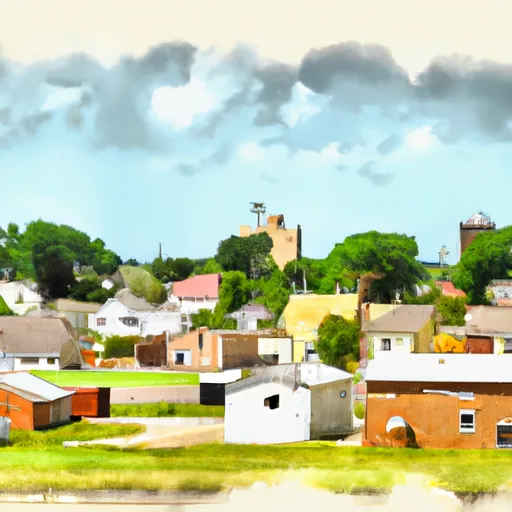-
 Snoflo Premium
Snoflo Premium
Get unlimited access to all our content
With no Ad interruptions! - Start Your Free Trial Login with existing account
Westfall
Eden Index
Climate
9.9
•
Recreation
•
Community
1.6
•
Safeguard
4.3/10

Westfall, Kansas is a charming town located in the heart of the Great Plains. The climate in Westfall is classified as a humid continental climate, characterized by hot summers and cold winters. Summers are typically hot and humid with temperatures averaging around 90°F (32°C), while winters are cold with temperatures dropping to around 30°F (-1°C). Westfall experiences moderate precipitation throughout the year, with the majority falling during the spring and summer months. The hydrology constituents of Westfall are mainly composed of rivers and streams that flow through the town, providing a scenic and tranquil environment.
Outdoor recreation opportunities in Westfall are abundant. The town is surrounded by beautiful landscapes, making it an ideal destination for hiking, biking, and camping enthusiasts. The nearby rivers and streams offer fishing and boating activities, allowing visitors to enjoy water-based adventures. Westfall is also known for its picturesque parks and nature reserves, providing opportunities for picnicking, bird-watching, and wildlife observation. Additionally, the town hosts various festivals and events throughout the year, showcasing the local culture and creating a lively atmosphere for residents and visitors alike. Westfall truly offers a diverse range of outdoor activities, making it a delightful destination for nature enthusiasts and adventure seekers.
What is the Eden Index?
The Snoflo Eden Index serves as a comprehensive rating system for regions, evaluating their desirability through a holistic assessment of climate health, outdoor recreation opportunities, and natural disaster risk, acknowledging the profound impact of these factors on livability and well-being.
Climate Health Indicator (CHI): 9.9
Westfall receives approximately
710mm of rain per year,
with humidity levels near 72%
and air temperatures averaging around
13°C.
Westfall has a plant hardyness factor of
6, meaning
plants and agriculture in this region thrive during a short period during spring and early summer. Most
plants will die off during the colder winter months.
By considering the ideal temperature range, reliable water supplies, clean air, and stable seasonal rain or snowpacks, the Climate Health Indicator (CHI) underscores the significance of a healthy climate as the foundation for quality living.
A healthy climate is paramount for ensuring a high quality of life and livability in a region, fostering both physical well-being and environmental harmony. This can be characterized by ideal temperatures, reliable access to water supplies, clean air, and consistent seasonal rain or snowpacks.
Weather Forecast
Streamflow Conditions
Smoky Hill
Area Rivers
Smoky Hill
Snowpack Depths
Smoky Hill
Reservoir Storage Capacity
Smoky Hill
Groundwater Levels
Recreational Opportunity Index (ROI):
The Recreational Opportunity Index (ROI) recognizes the value of outdoor recreational options, such as parks, hiking trails, camping sites, and fishing spots, while acknowledging that climate plays a pivotal role in ensuring the comfort and consistency of these experiences.
Access to outdoor recreational opportunities, encompassing activities such as parks, hiking, camping, and fishing, is crucial for overall well-being, and the climate plays a pivotal role in enabling and enhancing these experiences, ensuring that individuals can engage in nature-based activities comfortably and consistently.
Camping Areas
| Campground | Campsites | Reservations | Toilets | Showers | Elevation |
|---|---|---|---|---|---|
| Glen Elder State Park | 425 | 1,470 ft | |||
| Jewell State Fishing Lake | None | 1,684 ft |
Catastrophe Safeguard Index (CSI):
The Catastrophe Safeguard Index (CSI) recognizes that natural disaster risk, encompassing floods, fires, hurricanes, and tornadoes, can drastically affect safety and the overall appeal of an area.
The level of natural disaster risk in a region significantly affects safety and the overall livability, with climate change amplifying these risks by potentially increasing the frequency and intensity of events like floods, fires, hurricanes, and tornadoes, thereby posing substantial challenges to community resilience and well-being.
Community Resilience Indicator (CRI): 1.6
The Community Resilience Indicator (CRI) recognizes that education, healthcare, and socioeconomics are crucial to the well-being of a region. The CRI acknowledges the profound impact of these elements on residents' overall quality of life. By evaluating educational resources, healthcare accessibility, and economic inclusivity, the index captures the essential aspects that contribute to a thriving community, fostering resident satisfaction, equity, and social cohesion.

